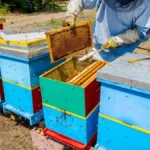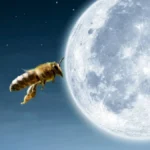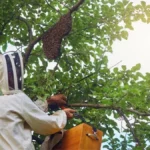In this article, we take a look at how to transport bees long distances. Bees have a long history of traveling around the world with us humans, and we will take a meander through this history.Â
A Quick Look At How Bees Move
If we look at a beehive, it is basically similar to a human city. Let us unpack this quickly with a few comparisons of the parts of the hive and parts of our city, so we can understand how to move bees long distances.
Infrastructure
Combs and propolis. Bees use combs to provide basic services in the hive – breeding areas, food processing, food storage, financial management of resources, cooling, heating, medicine, and resource prospecting.
Education/Worker Provision
The brood areas are similar to our schools, where bees are generated to be able to function in the hive economy. They achieve a generally higher employment rate than we do.
Financial Sector
The financial sector in a hive is the nectar storage area – this nectar is the working capital of the hive. Sugars are available for hive operation, expansion, defense, etc. Much like banks, bees control nectar capital allocation by the size of the nectar area. If abundant nectar is available, abundant expansion is possible. During times when there is no nectar, honey is diluted into nectar, and resource allocation from savings occurs to enable hive survival. This is a bit like quantitative easing. But more effective because bees don’t use nectar to buy toys.
Climate Control
Bees can ventilate the hive to cool it. Or they can heat the hive to survive in cooler times when they form the winter cluster. In our cities, we have similar systems, although our ability to manage a stable climate in cities is less effective than what bees achieve.

Defense And Policing
Bees have guards and worker police that manage and defend the hive against rogue elements in the hive and outside that pose a risk to the hive. In this way, the workers police against thieves from other hives, or naughty worker bees that try to lay eggs. They also defend against other predators such as humans, bears, baboons, birds, badgers, etc.
Resource Scouting
These bees are a bit like entrepreneurs/geologists in the human sense. Scout bees find nectar sources and then return to the hive where they do a pitch for that resource. A scout bee brings nectar back and does a dance to tell other bees where it is. She also provides a sample of the nectar. The other bees then perform an evaluation looking at the sugar content of the nectar and the distance from the hive. This allows bees to choose the most profitable nectar sources available and work with optimal efficiency. In some cases, this may be low-quality nectar close to the hive, because the cost-benefit analysis shows that the profit is higher than working high-quality nectar that is further away.
How To Transport Bees Long Distances?
If we look at a beehive as a city, we are tasked with moving our city from point A to point B. This is a complex task and must be done correctly to ensure that the movement of the city is achieved successfully. To this date, humans have not succeeded in being able to build fully transportable human cities, although we have dreamed and tried.
In order to move the hive, we have to ensure that we do not:
Damage The Infrastructure
In this regard, we use wax frames that are reinforced with wire or plastic when transporting beehives. If you move a hive that is not reinforced, such as a top bar hive, the combs break off and fall to the bottom of the hive creating a big disaster and destroying the hive.
Suffocate The Bees
When we move hives, we need to ensure they have space to hide inside the hive and enough ventilation. If bees do not have sufficient space, they can overheat the hive, which causes the wax to become soft and the brood to die. You can even end up with the entire hive actually suffocating. A large beehive has a greater oxygen consumption than an adult human when at full output, so oxygenation is important.
There are arguments about closing hive entrances when moving bees, or leaving them open. I generally use an Australian Migratory hive lid. This lid has a lot of advantages over conventional migratory lids. A conventional migratory lid provides a bit of spacing between hives that allows air to flow through the gaps. The Australian migratory lid has the advantage that it allows the bees to cluster at the top of the hive, drawing heat away from the brood nest. It is possible to put ventilation holes with gauze in these lids as well.
Many beekeepers will place an empty super on top of the box below the lid before moving it to create a bit more space for the bees to move to if they overheat. When transporting bees with a truck, this assists a lot.
Lose The Beehives
After loading hives on a pickup truck or truck, it is really important to secure the hives to the truck. A cargo net is useful to place over the hives. You can then secure the load with ratchet tie-downs. A useful note with pickup trucks is that you can actually tighten these things so tight that you either crush the hive or rip the fastener off your pickup – tighten within reason.
I once tightened hives poorly and arrived at the delivery point, and was missing 10 hives. Two years later, I was walking my dog on a mountain road and found the one hive wedged high up in a tree – and it still had bees. I left it there. There are significant liability issues around what happens to a beehive if it falls off a truck and ends up stinging or attacking somebody, hence the tie downs and cargo net are a good combination. Some people use tarpaulins, but this can reduce the bee’s ability to get air.
Travel At Night
Within reason, the best time for transporting beehives is at night. This is because they are all in the hive, and are less likely to fly away. I normally wait until close to sunset, smoke the hives, and load them. They are less angry just before sunset. After sunset, bees have a change in personality.
If it is possible to travel the entire distance by night, this causes the least disruption to the bees. You can then offload the hives at the destination site, and they wake up happily in a new destination and start their new day.
If you do have to drive further and move during the day and night, it does help to spray the bees down with water occasionally. This helps them get a bit of water to drink, and keep the hives cool. Not everybody does this, but I have found it helps. My work was at the scale of moving 50-100 hives – I have never migrated with semi-trucks with 500 to 1000 hives. This is a more complex endeavor.
Historic Migrations Of Bees
Prior to the introduction of the Langstroth hive in the mid-1800s, bees were kept in hives that did not have frames. Beekeepers would place sticks in the hives so that bees built the combs through the sticks. This provided strength. Such reinforced hives would travel on ships, and in this way, winter crossings of the Atlantic allowed bees to be moved from Europe to the Americas and further afield.
In Roman times, bees were weaponized, with Apis mellifera ligustica bees being transported on carts. Hives were flung into enemy villages and fortifications using catapults. It is important to remember that most men in those days work “skirt/kilt” like clothes and not trousers. Bees were incredibly effective at exploiting this weakness. This resulted in the inadvertent spread of the Italian bee throughout parts of Europe.
I hope this has helped you understand how to transport bees long distances. Moving bees is for me a traumatic experience and I wish you well in your endeavors! I have many memories of being covered in angry bees at night while changing flat tires in heavy rain and so on! Not for the faint-hearted, but definitely satisfying once the job is done and you watch the sunrise and the bees venture out into the new world you have found for them.

Dr. Garth A. Cambray is a Canadian/South African entrepreneur and beekeeper with 28 years of experience in apiculture and specializes in adding value to honey. His Ph.D. research developed a new advanced continuous fermentation method for making mead that has resulted in a number of companies globally being able to access markets for mead. His company, Makana Meadery, exports honey mead to the USA where it is available to discerning connoisseurs. He has also developed technologies to commercially manufacture organic honey vinegar in Zambia for export globally. He holds a few patents globally in the ethanol industry and believes in technology and knowledge transfer for human development and environmental sustainability. One of his proudest achievements is the fact that the wind farm he started at one of his old apiary sites has essentially made his hometown carbon neutral.






